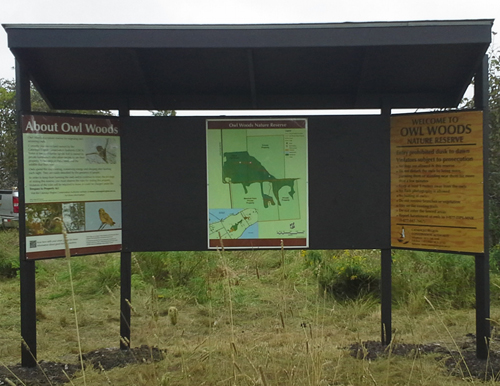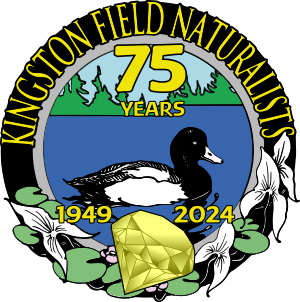The Owl Woods of Amherst Island
Amherst Island has, for many years, been noted for its wintering hawks and owls, and this area in particular, became well known for its concentration of northern owl species, particularly in those years when food supplies (small mammals) in the north were scarce, while there was an abundance here. The success of the meadow vole population and the types of trees available for hunting and roosting perches, particularly red and white cedar and jack pines, are the main attraction for the owls, and many remain for several days or even weeks during the winter, providing a wonderful opportunity for people to view and learn about these rare northern visitors.
Access to the Owl Woods is entirely dependent on the generosity of the private landowners. In November 2000, the Cataraqui Region Conservation Authority (CRCA) purchased 92 acres of adjacent land with funds donated by Loyalist Township, the Kingston Field Naturalists, and the previous landowner. The majority of the Owl Woods is owned by Gwen and Paul Lauret of Amherst Island, and the Barr family of St. Catharines. The Kingston Field Naturalists act as stewards of the property. A code of ethics is displayed in the kiosk to encourage visitors to minimize damage to the habitat and harassment of the roosting owls.
Owl Species
The most common owl species to be found here during the winter are the Northern Saw-whet Owl and the Long-eared and Short-eared Owls, with smaller numbers of Barred Owls and Great Horned Owls. Boreal and Great Gray Owls also appear in small numbers and in irregular cycles of four or more years. Elsewhere, throughout the island, Snowy Owls, as well as Short-eared Owls and sometimes, Northern Hawk Owls, are found in trees and on fence posts or hydro poles near open fields, where they hunt for voles or other small prey.
Location
The entrance to the Owl Woods is located at the double bend near the centre of the Marshall 40-Foot road on the east end of the island. The road may be accessed from either the North Shore or the South Shore Roads, but it is not maintained and is sometimes inaccessible by car in winter due to heavy snow drifts. At such times, it is approximately a 1.4 km walk to the entrance, but can be well worth the effort.
Owl Woods Management Strategy


Out of growing concern over the impact people are having on Amherst Island’s Owl Woods, working with the various landowners and stakeholders, the Kingston Field Naturalists began a project to find ways to minimize this impact. The KFN, in cooperation with the landowners and a professional biologist, produced a management strategy for the property. The document we produced is considered as a guide and a springboard for ideas rather than a rule book. Implementation of the recommendations began with the formation of the Friends Of the Owl Woods in Summer 2011. Following the strategy the Friends have now completed work on new interior signage, the fencing off of an owls only zone within the woods and a new welcome Kiosk at the entrance on the CRCA property. This kiosk displays the rules and provides a map as a reminder that the majority of the Woods is privately owned. Please respect this privately owned wildlife sanctuary, respect the owls and follow the posted rules.
The KFN would like to thank the following funders for their generous support of this project: HIVA Environmental Fund, L&A Stewardship Council, The Community Foundation for Kingston and Area (http://www.cfka.org) and the Cataraqui Conservation Authority.
Conservation Agreement to Monitor Evan’s Woods
Under provincial legislation, the Nature Conservancy of Canada has entered into a conservation agreement with Mr. Monte Hummel of Tottenham, Ontario concerning the conservation of 255 acres of his property known as “Evan’s Woods” near Verona, Ontario. This is a legal agreement by which Mr. Hummel voluntarily restricts or limits the type and amount of development that may take place on his land to conserve its natural features. The agreement’s restrictions are tailored to fit the particular property, the interests of the landowner and the natural features to be protected. It also provides for control over the future use and development of the property.
James Duncan, Property Donations Coordinator for Nature Conservancy Canada, requested the KFN’s help in the annual monitoring of Evan’s Woods by checking over the site to ensure that restrictions that Nature Conservancy has placed on it are not being breached. The KFN agreed to this request, and the first monitoring visit was conducted 27 May, 1997 by: Anne Robertson, Mike Evans, Vera Soudek and Bud Rowe of the KFN, James Duncan of Nature Conservancy Canada and Monte Hummel, the property owner. A Property Conservation Agreement Monitoring Report Form was completed by Anne Robertson after the visit and submitted to Nature Conservancy Canada.
Lost Bay Nature Reserve
The Lost Bay Nature Reserve was created in 1999 through the purchase by local cottagers and landowners of 108 acres of undeveloped land on the east side of Lost Bay on Gananoque Lake. The Federation of Ontario Naturalists (FON, now Ontario Nature) accepted title to the land and, on 15 Sept 2000 undertook a Conservation Agreement with the Nature Conservancy of Canada, establishing an easement for access to the Reserve for the purpose of creating a sanctuary for native flora and fauna and keeping the Reserve forever wild. In Feb 2001 the KFN entered into a Stewardship Agreement with the FON in which the KFN was tasked to: compile basic natural history information, conduct site visits to note any human use, patrol and protect the Reserve and answer any local inquiries about the Reserve.
The Reserve is located on the Algonquin-to-Adirondack corridor, on the Frontenac Axis and within the new Frontenac Arch–Thousand Islands Biosphere Reserve. It is made up of Great Lakes–St. Lawrence Islands forest types and has provincially significant wetlands, providing an opportunity for a good selection of species. The KFN held a BioBlitz at the Lost Bay Nature Reserve in June, 2005. Despite wet, cool weather, sixty-eight participants tallied a grand total of 465 species, a new record for the event at that time.
Mitchell Creek
The Mitchell Creek property is owned by the Nature Conservancy of Canada. It is on the northwest side of Frontenac Provincial Park on the Canadian Shield. This 131-acre tract has about 5000 feet fronting onto the north shore of Mitchell Creek east of Snug Harbour. It is almost all forested, with a series of ridges and valleys and a talus slope. This property is monitored annually by the KFN.
Greenwood Wildlife Sanctuary
The Ontario Heritage Trust was given almost 100 acres of land by Mary Greenwood, a former Kingston resident. The property, approximately 1 km west of a sign erected in the Helen Quilliam Sanctuary, can be reached along the Greenwood Track. The property was named the John Edward (Ted) Greenwood Wildlife Sanctuary at a ceremony held in August 2007. The KFN acts as the custodian of the property.
For more information on any of the above, please contact info@kingstonfieldnaturalists.org.
